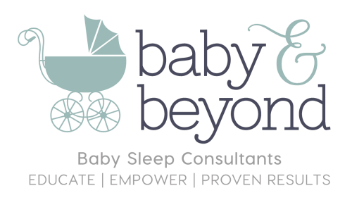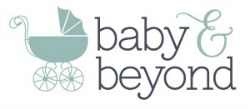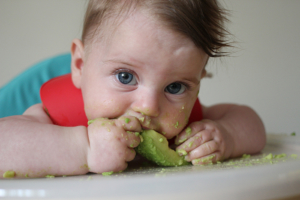If you’ve heard of baby-led weaning, but not sure of what’s involved, have a read of our quick guide. From suggestions on when to start baby-led weaning, foods to try, preparing for the mess and reasons why baby-led weaning may not be suitable for your baby.
What is baby-led weaning?
Baby-led weaning is a way to introduce babies to solids. Put simply, baby-led weaning (BLW) is when your baby takes control of feeding themselves and what they’re eating. They learn to pick up and eat food by themselves, rather than being spoon-fed pureed or mashed food or food that is cut into very small pieces.
Over time a BLW baby learns to put food into their mouth, bite it into manageable pieces, move the food to the back of their mouth and eventually they learn how to swallow it. Whereas spoon-feeding a baby promotes the instinct to swallow before they learn to chew.
Either way, both methods eventually end up with a toddler who has learnt to swallow and chew. It’s really a matter of preference as to how you introduce your little one to solids.
When to start baby-led weaning
All babies are different, but generally from around 6 months old your baby will be able to sit up straight, pick up food and put it into their mouth.
It is very important when using baby-led weaning that you don’t rush things. Wait until your baby starts showing an interest in food and then take each day step by step. Their general motor development is also an indicator of their readiness to eat and digest solid food. By not spooning food into them you are allowing them to develop these skills when they are ready and at their own pace, as they do with sitting, walking and talking.
When you start BLW you’ll find that your baby won’t eat food straight away. It may take days, weeks or months before they even swallow a bite, but that’s not a problem. BLW offers babies the chance to explore foods and enjoy different food textures when they’re ready.
Look at these early ‘meals’ as play sessions rather than ‘food’. These meals will be about learning how to eat and learning about texture and flavour.
The amount of food that goes in will gradually increase. It will slowly introduce their gut to the work it will need to do in order to digest a wider range of solid food later on.
Foods to try
If you would like to try BLW, offer your baby a selection of nutritious finger foods and allow them to select what they would like to eat. Don’t overwhelm them with too many pieces of food, two or three items at a time is enough to begin with.
At first, your baby may just play with the food. They may grab pieces of food with their fist and start to suck on them. During this time carry on giving them breastmilk or formula milk in between meals. As they gradually eat more solids, the number of milk feeds can start to decrease.
The idea behind BLW is that you don’t need to cook special food for your baby, you can give them what you’re eating in a form that they can pick up and eat. Give them pieces of your family meals, or things you have in the house already. Just avoid foods which contain too much sugar and salt.
The easiest finger foods for young babies to eat are those that have been cut like a chip, or have a handle, such as cooked broccoli spears. This is because when your baby first tries solids, they won’t yet have developed a pincer grip. This will develop in the coming months, but at around 6 months old they can only clasp food in their fists.
First food ideas include: fusilli pasta, cooked carrot sticks, cooked broccoli florets, toast and butter, melon, banana or slices of other soft fruits, roasted potato, roasted parsnips, home-made pizza. Cut rounded, skinned fruit like grapes and tomatoes into halves or wedges to make them easier to eat.
Hard foods that break in chunks like raw carrot or raw apple wedges and pear are best avoided in the early stages as they are potential choking hazards. Once your baby learns to use a pincer grip (holding things between a finger and thumb) you can introduce smaller items such as berries and raisins or even peas and corn.
Place the food on the tray of your little one’s highchair, and then let them eat with their hands. No special plates or cutlery required. Remember to never leave babies alone whilst they are eating and avoid those foods not recommended for young children like whole peanuts (choking hazard) and honey (botulism).
Be prepared for the mess
As you’ll discover the BLW process is very messy, and there is often a lot of waste. You’ll definitely need a philosophical approach to cleaning!
An easy-to-clean high chair is a real benefit when you’re baby-led weaning because your baby is likely to throw, spill and generally lose most of their meals, rather than eating them!
For the same reason, putting a big wipe-clean mat under their highchair can be useful too, especially if you have carpets rather than hard flooring. Bibs (lots of them!) with full arms sewn in them are also a good idea.
Learning to let go
A hard aspect of this method of weaning can be relinquishing your control. You really have to be able to step back and trust your baby to get on with it. Don’t help to put any food into their mouth and don’t worry if you think they haven’t eaten enough.
Food is all about experimenting and learning at this stage. They will still be getting the nutrition they need from their milk.
Reasons why baby-led weaning may not be suitable
Talk to your doctor or health specialist before trying baby-led weaning, especially if any of the following apply to you:
- you have a family history of allergies, digestive problems or food intolerances
- your baby has special needs and can’t chew very well or has difficulty picking up food and moving it to his mouth
- your baby was born prematurely
Research on baby-led weaning in NZ
At this stage very little research has been done on baby-led weaning worldwide. Before the NZ Ministry of Health can ‘recommend’ baby-led weaning to the public as a safe alternative to current advice, it needs evidence that baby-led weaning doesn’t lead to babies being:
- iron-deficient
- not growing well
- Increased chance of choking.
The Ministry needs evidence of the benefits before it can recommend baby-led weaning as the best practice for babies in New Zealand.
More research is being done on baby-led weaning and the Ministry will review this as it becomes available.


